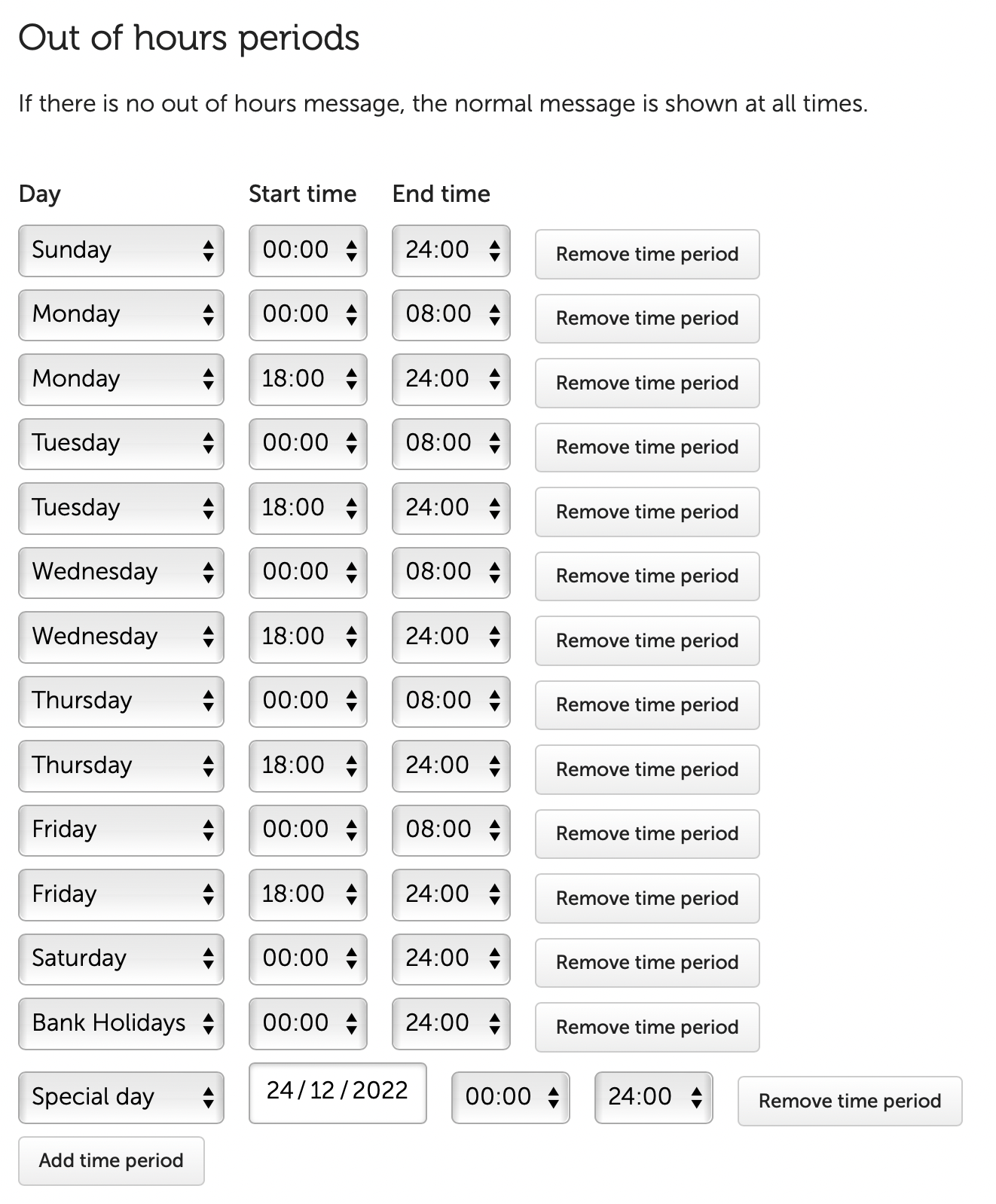Staff users in FixMyStreet
Privileged accounts with access to management features.
Staff users are a middle rung of account, inbetween normal users of the site and superusers with full access to everything. They are associated with a particular body, and can have access to different features, depending upon the permissions or roles granted to them. All their abilities only apply to reports made to the body with which they are associated; all staff users have access to all report states, not just open/fixed.
Viewing all reports in your area
If you want to view everything that’s been reported within the council area, here’s the quickest way.
Click on ‘all reports’ in the top menu. You’ll see the boundaries of your council area on the map, and a list of all reports listed, with the most recently updated reports at the top, in the left hand panel.
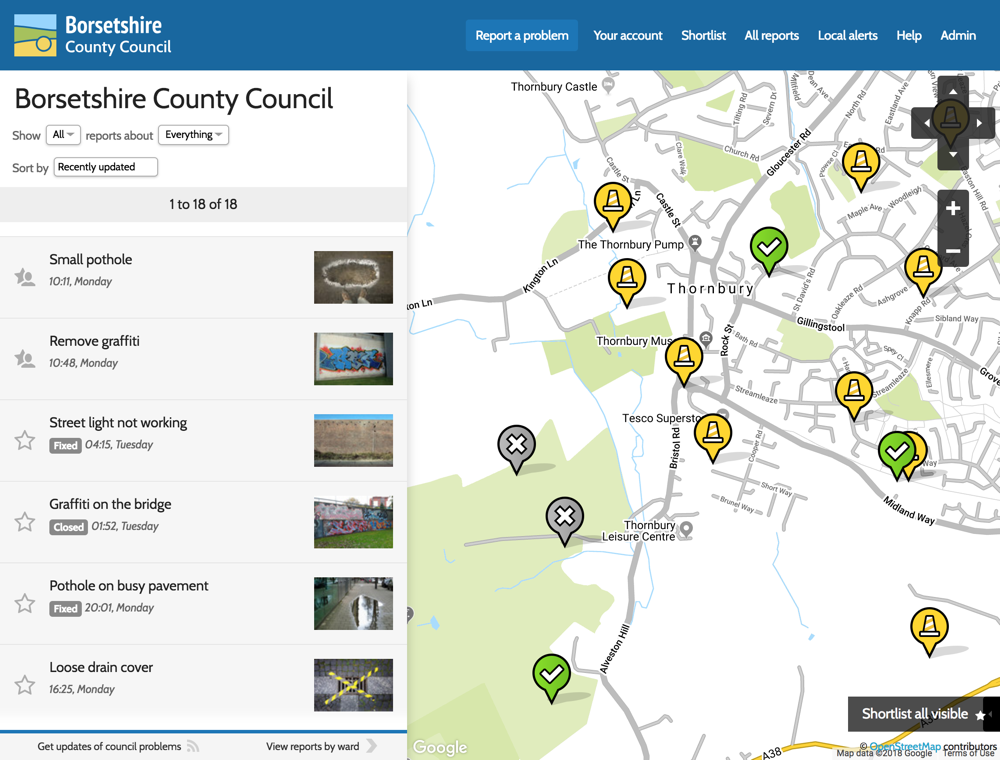
Note that staff members can be allocated one or more category (e.g. potholes, streetlights, etc) by the Administrator — see ‘Creating a Staff Account’ for more details. When logged in, these staff members will only see reports within those categories by default.
Defining the area of interest
If required, you can also use the controls to the right of the screen to zoom in or out, or pan across the map. As you’ll see, the list of reports and URL (web address) always reflect the area you are viewing on the map, so this is another way of refining your view.
Once you’ve found a satisfactory view, and if you are likely to want to revisit it, you can bookmark or otherwise take a copy of the URL displayed in your browser, so you don’t have to define the location again in the future.
Viewing a report in a specific area
If you already know the street name or postcode of the location you’d like to view, you may find it quicker to use the search form on the front page.
Filtering and sorting reports
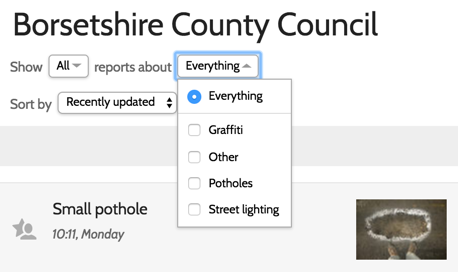
The drop-downs at the top of the report list allow you to filter which reports you see, by state (e.g. ‘Fixed’ or ‘In progress’) and category (e.g. Potholes or Graffiti). You may also sort them by date created, how recently they have been updated, or number of updates.
Viewing a single report
Click on one of the issues in the list, or on a map pin, to view the full report. See ‘Dealing with undesirable content‘ below for how to moderate or hide a report.
Searching for a report
Click on ‘admin’ in the top menu bar.
There are a number of different options for using the Search Reports box:
- Enter any word contained in the required report’s title or body
- Search by the report-maker’s name (or part of the name), their email address or phone number (where given).
- Search by the report’s ID number if it’s known. Putting ‘id:’ directly before this number in the search box will speed up the return of results.

The search will return a list of all reports that fulfil your parameters. Depending upon the staff user’s permissions, you can then either click on the report’s ID number to open the report in a new browser window and access the moderation/ editing/ inspection facilities there; or click on the word ‘Edit’ to access the full report admin editing page.
User admin
In the admin, enter any part of the user’s name or email address in the ‘Search users’ box. You may click on ‘Edit’ beside any user to view or change their account details, click the user’s email address to view a list of all reports and updates made by that user, or click ‘Timeline’ to see a timeline of that user’s activities on the site.
Viewing reports as a non-staff user
As a staff user, your view of a report includes moderation functions which ordinary users do not see. If you would like to view a report as a member of the public would see it, there are three options:
- Log out of FixMyStreet, or
- Start a private browsing session, or
- View the page in a different browser (e.g. Chrome rather than Internet Explorer), in which you are not logged in to FixMyStreet.
Any of these courses of action will allow you to view the site as an anonymous visitor, with no recognition of your staff role.
Creating reports/ updates on behalf of another user/ the council
If a resident makes a report or update by phone or in person, staff members with the appropriate permissions can add it to FixMyStreet on their behalf. The report will be anonymous on the site, but the resident’s name will still be available in the admin interface. Reports can also be made as if from the council.
Staff should make a new report just as a member of the public would — see ‘The citizen’s experience’. Those with the appropriate permissions will see a dropdown box in the report-making interface, labeled ‘Report As’. Select either the council, ‘yourself’, ‘anonymous’ or ‘another user’.
In order to reduce confusion for customer service staff, the email, name and phone number fields in the reporting and update pages are disabled for staff users. This avoids accidental overwriting of their own details with those of e.g. citizens making reports over the telephone in case staff forget to switch the ‘Report As’ control to ‘another user’.
If a user has the ‘Default to creating reports/update as the council’ permission then the dropdown will default to reporting as the council. Staff with the ’Markup problem details’ permission will also default to reporting as the council.
When a staff member makes an update on the site, it will not be publicly displayed with the staff member’s name, but the name of the body to which the user is attached. Staff members with the ‘See user detail for reports created as the council’ permission will be able to see the staff user’s name on the report or update, but other staff and the public will not.
Dealing with undesirable content
Fortunately, abuse of FixMyStreet is fairly rare: undesirable content represents a tiny fraction of the reports made each year. But of course, you need the tools to deal with it, and there are other reasons you may wish to edit a report, too. We estimate that somewhere in the region of three in every thousand reports will require moderation, based on figures from other councils.
Reasons for moderation
- Personal information such as the accidental inclusion of contact details in the report body.
- Potentially libelous content such as complaints about illegal or anti-social behaviour which implicate an identifiable individual.
- Abusive content such as profanity or unsuitable images.
- Council staff may have added an update which they now wish to alter, eg because of a spelling mistake (if the report’s status has changed or a factual error was made, we recommend a new update rather than editing an existing one).
We recommend a ‘light touch’ approach to editing, in which any content from a user, other than those types listed above, is left intact. For example, there is no need to correct a report-maker’s spelling or grammar unless they request that you do so.
Moderating reports
When logged in, staff with the required level of permissions can moderate reports directly on the report webpage. You will see a ‘moderate’ button below the report’s main body, and above each update. Clicking this button gives you the ability to:
- Edit the title or body text
- Remove a user’s name
- Remove, redact or restore photographs
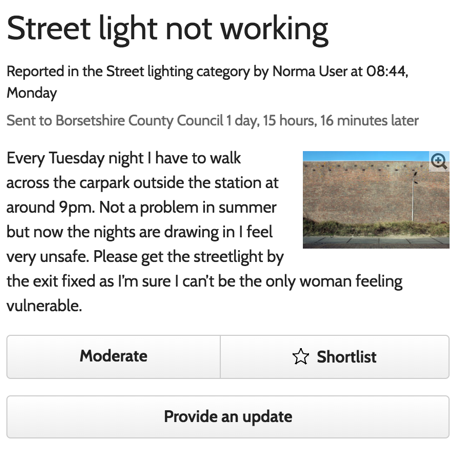
You can also add a note to indicate the reason for the change to the report.
Moderation history will be shown within the report updates, and is only visible to people with the moderate permission.
Redacting photographs
When moderating, each photo has an associated “Redact” option. Selecting this opens up the full size photo, on which you can draw black rectangles if you need to hide a section of a photo without removing the entire photo.
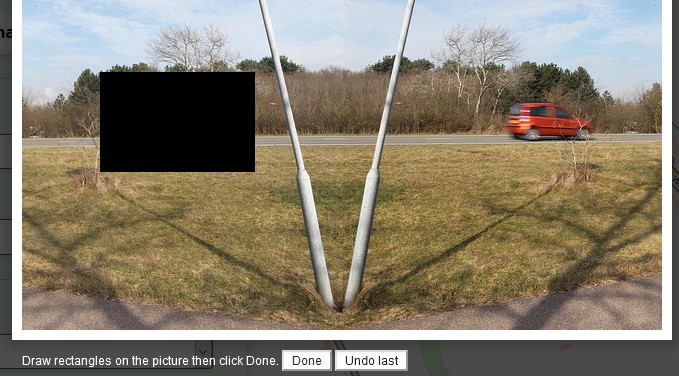
Hiding reports
Clicking the moderation button also gives you the option to hide an entire report or its updates. ‘Hiding’ means that the report is no longer visible to the general public, but it remains in the site’s database and is accessible to staff with admin permissions.
Once a report is hidden, staff without admin permissions can no longer access it — so if, for example, they hide a report by accident and wish to revert it to public, they must contact a team member with the appropriate permissions.
Removing users’ names
When users make a report on FixMyStreet, they may choose not to display their name on the public web page. If a user accidentally chooses to display their name and then wishes to remove it, they can do so themselves when logged in to FixMyStreet.
However, if necessary, council staff can also remove a name from a public report on behalf of the user: see ‘moderating reports’.
Adding a user to the abuse list
You can add an abusive user’s email to the abuse list, which automatically hides any reports they create, and means that their reports are not sent. Instead, the user sees a message that there was an error in confirming their report.
Staff with the required permissions can ban a user directly from their user admin page, using the ‘Ban user’ button.
Removing users from the banned list
When a user has been banned, an ‘unban’ button will be visible on their user admin page. This restores them to the status of a standard user, but it does not have any effect on reports which were made during the period when the user was banned — these remain unsent.
Creating/Viewing private reports
If a you are creating a report that has to contain information that should not be make public, e.g. Names and addresses, then you can create a Private report. This will still be visible to staff members with the relevant permissions and will be sent as normal but will not be visible to members of the public.
You can also mark an existing report as private by visiting the report page while logged in, checking “Private” and clicking “Save Changes”.
In such cases, staff should make a new report just as a member of the public would — see ‘The citizen’s experience’. Those with the appropriate permissions will see a “Private” checkbox underneath the user details which they should select.
On the reports page you can select “Private only” from the status filter to display only the reports that have been marked private.
Correcting reporter errors
Changing a report’s category
If the user has chosen the wrong category for their report, when logged in, staff with the appropriate permissions can change it from within the on-page editing interface, from the dropdown to the right of the report.
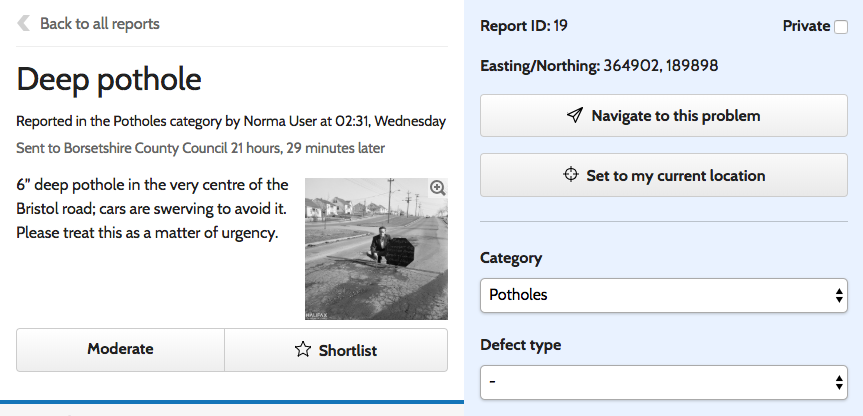
If changing the category of the report results in it becoming the responsibility of another authority, the report will be re-sent to that authority. Do not mark it as closed, even though you have now dealt with it as far as your council is concerned; from the other authority’s point of view, and for the person who made the report, the status is still open.
However, if the report remains your council’s responsibility, the category change does not re-send the report unless the send method has changed (e.g. in the case of councils where some reports are sent via the Open311 protocol and others by email).
Changing the location
- You can click and drag a pin at any time to change the report’s specified location.
- When viewing a report on the ground, staff with the appropriate permissions may click ‘set to my current location’. This will reset the co-ordinates of the issue to reflect a more accurate placement.
Keeping the report-maker informed
Updates can be left on a report in order to keep the creator of the report, and the wider public viewing the site, informed on what is happening with the report. Staff members can update the state of the report if necessary, including states such as ‘in progress’ or ‘no further action’, plus leave a textual update to explain in more detail.
Many issues require identical or very similar responses. Rather than type your reply out each time, staff can choose from a number of pre-written (but still editable) template responses, such as ‘Thank you for your report, we’ll be back in touch with an update soon’, ‘Repairs are now underway’ and ‘This issue is now closed’.
Status updates
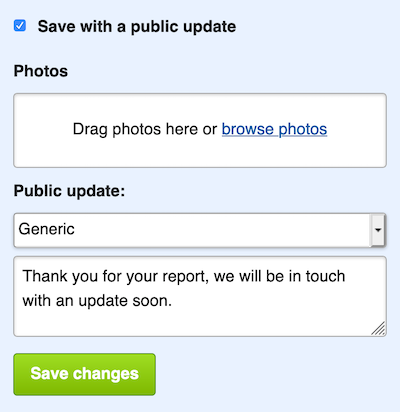
From the report page, staff with the appropriate permissions may select from the ‘public update’ dropdown. This will prefill an update with template text for one of a number of common statuses. The templates are created by the Administrator; see ‘Creating response templates’.
The text in template responses is fully editable on the report page, so staff may also choose to add their own comments or edit the preformatted responses to reflect the precise circumstances of the report. Alternatively they may write an entirely new status update.
In some cases, template responses are automatically attached to a report state — for example, setting the report state as closed may automatically select the template ‘Issue closed’. See ‘creating a template’.
If ‘Create reports/updates as the council’ is ticked in the staff user’s account permissions, their updates will be labeled as from the council rather than the staff member’s name. For the sake of staff privacy, this is usually preferable.
Staff with appropriate permissions can also attach an image to the update, which will then be displayed publicly alongside the text update.
This option is also available via the general ‘Update’ box under the main report.
Requests for more information
Depending on your preference, you may request more information by contacting the user directly, or by leaving a status update on the report that asks for the details you need. Both will reach the report-maker; the difference is that a status update can also be seen by anyone viewing the report online.
Prioritising tasks

Setting a priority
From the panel on the right hand side of a report, staff with the appropriate permissions may select a priority from a drop-down list. These priorities are created by Administrator-level users; see ‘Setting categories and priorities ’.
Working with shortlists
You can easily create a shortlist of reports that you need to inspect, and arrange them into the order that suits you best. Once that’s done, you can consult them via a mobile device — even when offline — or, if you prefer, print the list out on paper.
Making a shortlist
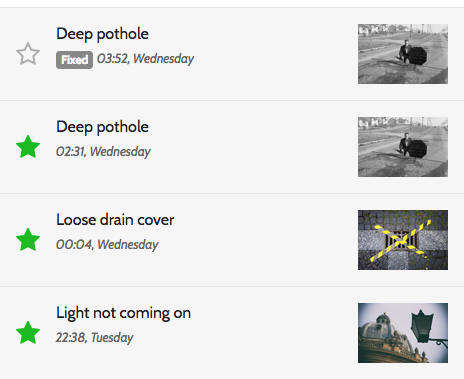
First, navigate to the ‘All reports’ page where you will see issues listed on the left. In most cases, it’s useful to leave these in their default of ‘sort by newest’ so that you see the most recent reports first, and to use the dropdown to filter the reports so that you only see those which have an ‘open’ status. You may also wish to limit your results to a specific category. See more about filtering and sorting reports.
Once this is done, you can add a report to your shortlist by clicking on the star beside it. The star will turn green to indicate that it has been added. Click the stars by any report which you wish to investigate.
At a certain level of zoom, there’s also the ability to ‘add all reports visible to shortlist’, which allows you to make a bulk addition of everything within the area.
Alternatively, you may add a report from within the individual report page. Adding a report to your own list will remove it from any other staff member’s list to which it has previously been added.
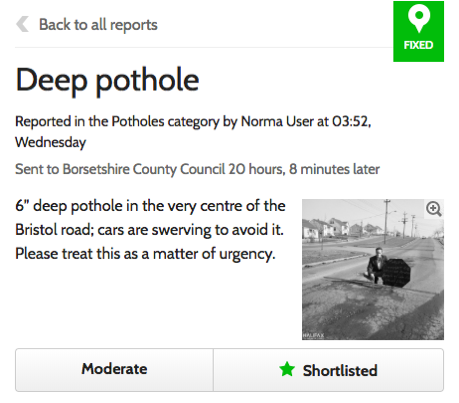
Viewing, editing and sorting the shortlist
Click on ‘Shortlist’ in the top menu bar and you will see all the reports which you’ve selected. You can continue to add more reports by returning to the ‘all reports’ page.
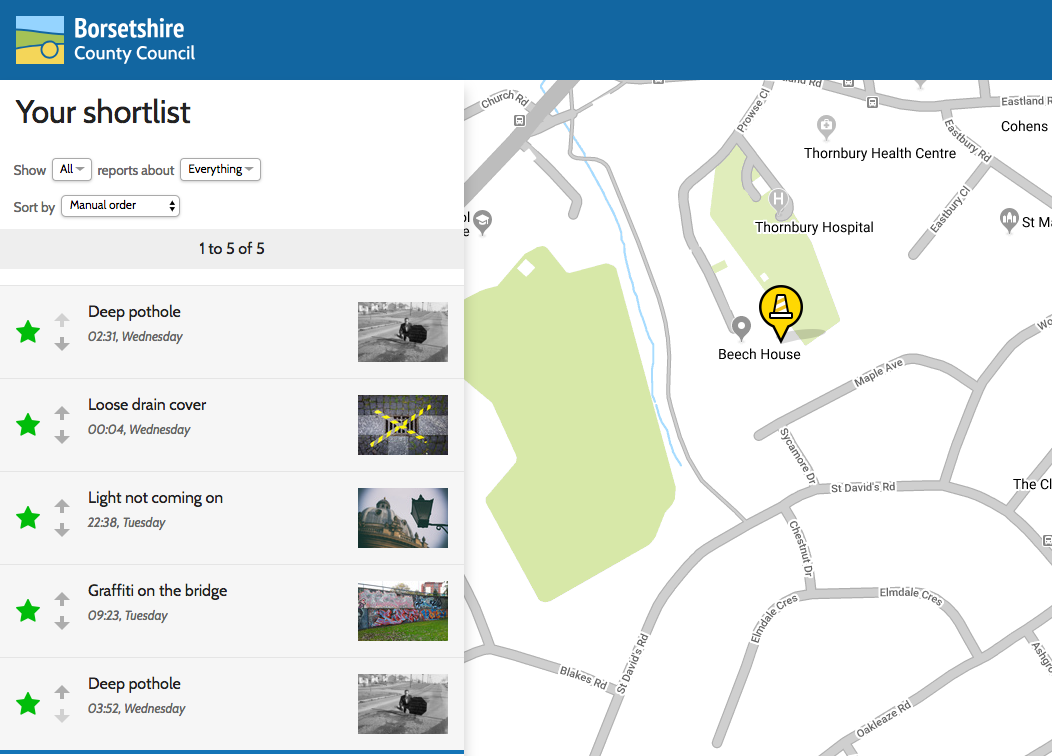
If you wish to remove a report from your list, click on the green star again. This can be done on the individual report’s page, from the ‘all reports’ page, or from within your shortlist.
Shortlists can be ordered and filtered in the same way as the main list, by using the dropdown menus. You can also use the arrows beside each report title to move them up or down the list, until they are in a practical order for your route or priorities.
Assigning reports to another user’s shortlist
Managers of teams of inspectors can assign reports to the shortlists of inspectors (i.e. staff with the ‘Markup problem details’ permission). The assignment dropdown appears when editing reports with the inspector tool, but only if there are any users available to be assigned.
Reports can also be assigned in bulk from the ‘All reports’ page, where inspector managers can see at a glance which reports are assigned to which inspectors.
Assigned users can also be viewed on the Reports list page in the Admin area, as well as when editing a report in that list by clicking its ‘Edit’ link.
Seeing which reports are assigned and unassigned
In addition to seeing their own shortlist, inspectors can, like inspector managers, see which reports are assigned to other inspectors, both in the individual report webpage and in the ‘All reports’ list.
Viewing navigation routes
From any report, you can click the button marked ‘navigate to this problem’. This will open a separate tab in your browser, and plot a route on Google maps from your current location.
Viewing and editing reports offline
Sometimes it’s useful to be able to see and update reports even when you’re offline — perhaps in areas with low mobile connectivity, or because you want to save data. FixMyStreet Pro will let you do this, and then it syncs everything up when you’re back online.
Visit your shortlist page before you go out and about: you’ll see a message that the list is being cached for use offline. That means that whenever you are viewing the page without an internet connection, you’ll be able to see the reports — make sure you have the shortlist page bookmarked so that you can find it when you need it.
While offline, you can view reports, create and edit updates. The changes will all go live once you go online to sync.
Syncing
To synchronise your records once you’re back online, just visit any page on FixMyStreet and click the prompt to submit your changes.
Administrating staff accounts
Creating a staff account
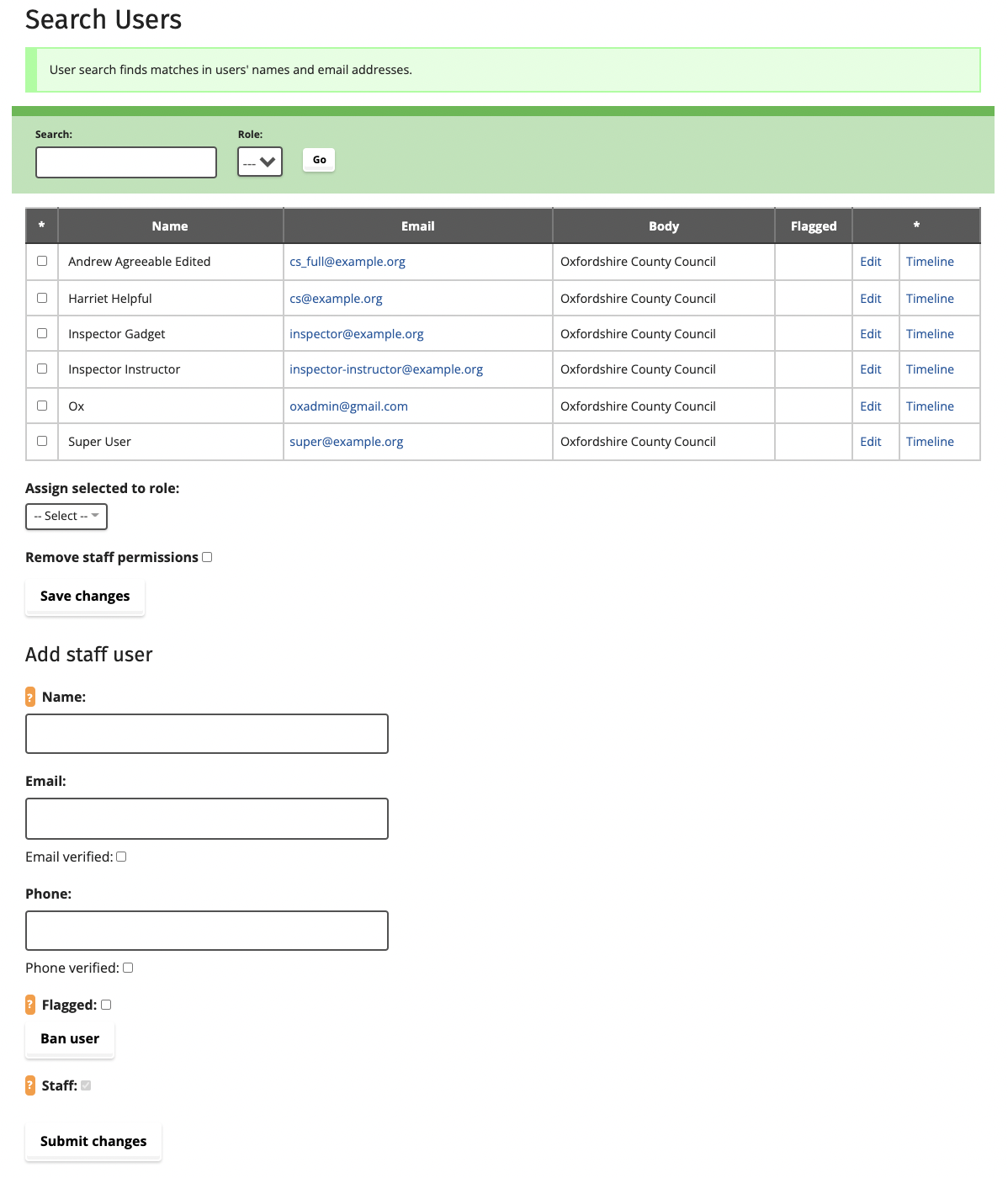
Go to the ‘Users’ tab in the admin menu.
You’ll see a table of existing users. Below this is the ‘add user’ interface.
First create the basic user account by inputting a name and email address, plus any other contact details desired. Once this is done and you have saved the input, you can edit the account to assign any roles or permissions required.
The ‘Staff’ checkbox cannot be unchecked; this guarantees a new user will be a staff user, and will be automatically assigned to the correct body.
The new staff user can then log in via the normal method.
Creating roles
Go to the ‘Roles’ tab in the admin menu.
Here you can create a group of permissions, called a ‘role’. See Staff user accounts for some possible examples, but you can use whatever makes sense to your own organisation.
Once you have created a role, you can then assign a user to one or more roles to give that user access to all the permissions of those roles, without having to assign permissions individually for each user.
Assigning roles and permissions
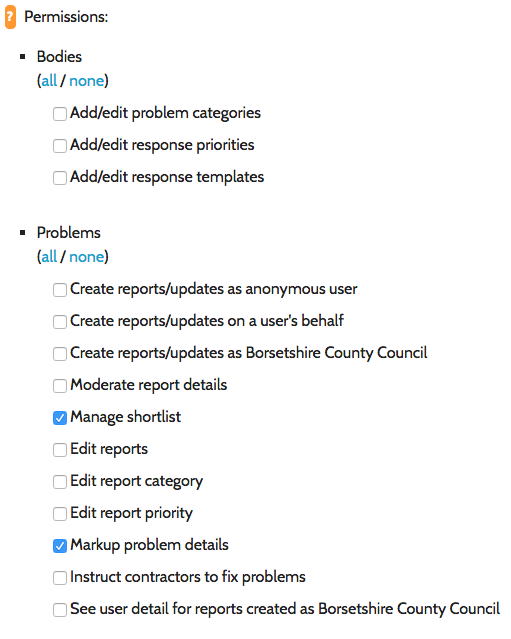
Once you have created the basic staff user account, you’ll be taken to a page where you can assign roles and permissions.
You can also always edit any user from the table at the top of the Users page by clicking ‘edit’. Select the roles or permissions you wish that user to have, and click ‘submit changes’.
Setting categories to users and roles
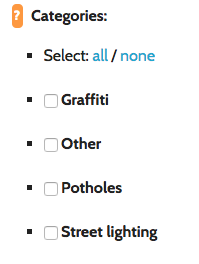
The Administrator can allocate one or more categories of report (e.g. Potholes or Highways maintenance) to a staff user by editing the user and checking the relevant category boxes. The staff user, when logged in, will then only see reports within those categories. This is useful where a staff user only deals with reports of a specific type.
Roles can also have categories associated with them. This works in the same way as assigning categories to a user. You can assign categories to a role by editing the role and checking the relevant category boxes. By default, users will then be shown a filtered list of categories relevant to their role.
Please note: there is no restriction functionality to prevent users from seeing other categories by removing the default filter. However, this can be done if required by:
- Ticking “Frontend staff access only to users assigned to this category” on a particular category page - this restricts the category, so that only staff assigned to that category will see staff-related features.
- Ticking “Assigned categories only” on a user’s page - this restricts that user to only see front end staff features in their assigned categories.
Removing staff status from accounts
To remove the staff status from an account visit the user page and uncheck the ‘staff’ checkbox. To prevent a user from logging in uncheck the ‘email verified’ checkbox.
You can do this in bulk on the Users screen by selecting the checkbox next to the user’s name on the users page, selecting the ‘Remove staff permission’ checkbox and clicking submit.
Note that if a user has access to the email address associated with an account they can re-enable their account, but will not have staff permissions.
Removing accounts
To remove an account, the Administrator-level member of staff should make contact with mySociety.
Two-factor authentication
Any staff user can choose to set up two-factor authentication on their account. To do this, they will need an app on their phone that can generate time-based authentication keys, such as Google Authenticator or a password manager. Then. they can visit their account page on the site and select ‘Activate two-factor authentication’ to receive a QR code to scan with the app.
If you wish your organisation to have mandated two-factor authentication, please get in touch.
Creating and editing categories
Note
If your FixMyStreet Pro installation has been integrated with a CRM system, this section might not fully apply; it is possible categories are managed from within the CRM, and FixMyStreet will be set up to work with these. Some installations only integrate on some categories, and some sections such as form disabling can still be used on top of an integration.
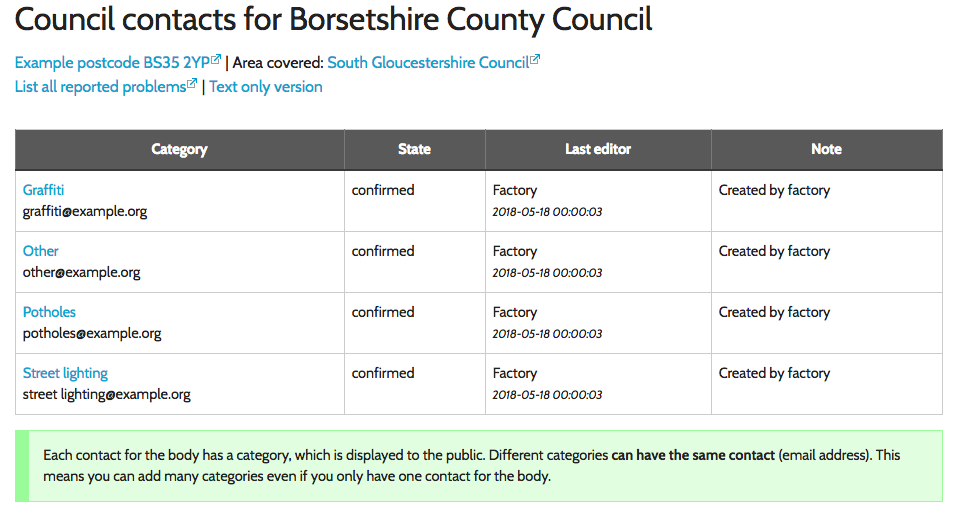
Creating a category
Those with the appropriate permissions can dictate which categories the site displays when a report is being made.
These categories also become one of the criteria by which all users — both members of the public and staff users — can filter reports when viewing them on the site.
From the Admin menu, click on ‘Categories’. You’ll see a table of existing categories, and below that, a form by which you can create new ones.
Input a title for the category, and the email address to which reports in that category should be forwarded. When creating a category, these are the only fields required.
You can also choose a variety of options – whether to automatically hide any reports made in this category, whether to prevent form submission when this category is selected, whether updates are allowed on reports in this category, whether members of the public can reopen fixed/closed reports in this category, or what parent category or categories a particular category is in. See below for information on creating/editing extra notices and questions for a category.
You may also be able to configure categories to allow anonymous reporting if you have this option available. If this is not available then contact us to discuss it.
Categories can be made ‘staff only’, where they are only available to logged-in members of staff, not members of the public. This could be used for e.g. contact centre staff to leave reports in categories that you still want to be phoned in.
Categories can be marked as a litter category for when the council is responsible for litter on parts of a Highways England road. This will mean the category will be included in the Highways England categories for any relevant stretch of road.
You can set up as many or as few categories as you like, and each category can have its own email address attached to it, so for example, reports about potholes may go to one council email address, while reports about road signs go to another. More than one category may share the same email address, if required.
For the best user experience, categories should be limited to no more than 20, and should be fairly broad — so for example, one category titled ‘Parking’ is better than several titled ‘Bad parking’, ‘Car parks’, ‘Parking meters’, etc — especially if all the reports end up in the same mailbox. Fewer and broader categories ensure better accuracy in the routing of reports that you receive, as it is easier for a user to identify the correct one.
Category titles should, as far as possible, use language that residents of all levels of experience or education are likely to understand, rather than internal council or highways management jargon (such as ‘paths’ rather than ‘footways’ and ‘roads’ rather than ‘carriageways’ or even ‘highways’). We always recommend the inclusion of one category titled ‘Other’, for reports which do not fit into any pre-existing category. This should route emails to a general mailbox from where a member of staff can forward them to the most suitable destination.
Editing categories

You can edit categories at any time by clicking on their title within the table at the top of the Categories page.
From here, you can change the email address that the reports in this category are routed to, or any of the other options for the category, such as the hint text shown to the user for this category, whether reporting should be disabled when this category is selected, or whether updates should be disabled on reports in this category.
Creating and editing category notices and questions
Note
If your FixMyStreet Pro installation has been integrated with a CRM system, some of this section may not apply, e.g. extra questions may be pulled directly from the backend.
Each category can have additional notices and questions associated with it, called “Extra data”. You can add as many as necessary (though we do recommend as few as possible, to stop people being put off from filling in your form), reorder them, and update them. No extra data answers are shown in public by default.

Notices
A notice is some text that is displayed to the user when the category is selected. This can be used to provide extra information about the category, point specific cases elsewhere (e.g. a phone number for urgent enquiries), or anything else you think the reporter may find useful.
HTML content in notices
Sometimes it can be helpful to use different text formatting or include images in the notices shown to users. You could, for example, include photos that illustrate the sorts of issues users should report in a particular category.
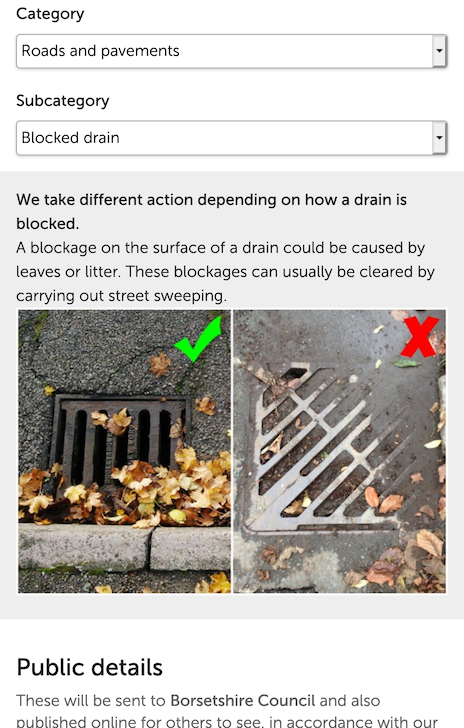
The Notice text field allows you to include HTML tags to apply text formatting, add links, or include images in the notice shown to the user. The above notice was generated from this HTML:
We take different action depending on how a drain is blocked.<br>
<span style="font-weight: normal">A blockage on the surface of a drain could be caused by leaves or litter. These blockages can usually be cleared by carrying out street sweeping.</span><br>
<img src="https://www.borsetshire.gov.uk/images/BlockedDrainExamples.jpeg" alt="Compared with a surface blockage, an internal blockage could be caused by leaves, mud, or stones and need specialist equipment.">
The following HTML tags are allowed for use:
pulollibrbistrongema- The following attributes are allowed:
href,style,target="_blank",title
- The following attributes are allowed:
img- The following attributes are allowed:
src,alt,width,height,hspace,vspace,align,sizes,srcset - NB The
altattribute is required if you’re giving information only present in the image.
- The following attributes are allowed:
span- The following attributes are allowed:
style
- The following attributes are allowed:
Any other tags or attributes not allowed by the above list will be stripped out when you save your changes on the form.
Questions
A question can ask the user to provide some specific additional information that you require in order to treat the problem appropriately, such as what specific type of issue is being reported, or some additional details you require to take the report forward. It can either be a free-text field, or a drop-down, where you can specify the options to be picked from.
You can also selectively disable the form submission process based upon a drop-down question answer - for example, if you had a question asking if the situation was dangerous, you could disable the form if the reporter answered Yes and display a message asking the user to ring a number instead.
Hidden/internal data fields
As well as questions and notices, you can set up hidden and internal data fields. A hidden data field will be output in the reporting form HTML (so e.g. clicking on a map asset could fill this field with the asset’s ID), whereas an internal data field is not output in the HTML (this is for special fields that your server knows to accept, e.g. different co-ordinate systems, special handling of textual input, and so on).
Creating and editing priorities
Priorities indicate the relative urgency or importance of a report. You can set them to reflect your own internal prioritisation system; there’s also space to add priority codes to comply with external services that reports may be passed on to.

Create a new priority
Click on ‘Priorities’ in the admin menu. You will see any existing priorities listed in a table. Click ‘New priority’ to add a new one, then provide the following details:
- Name Give the priority a name which will be recognisable when it is being chosen from a dropdown list within a report, e.g. ‘High priority’.
- Categories Priorities can be applied to one or more category of report: check the boxes to indicate which categories.
- Description Include a description of the priority, e.g. ‘Four hour fix’.
- External ID Any code that needs to be passed on to external contractors or services. - Default priority Tick the box if this priority applies to all reports by default.
Edit an existing priority
Click on ‘Priorities’ in the admin menu. You will see any existing priorities listed in a table. Click ‘edit’ to make changes to an existing priority, and change any of the following, as required:
- Name The identifier which appears, to staff with the appropriate permissions, in the dropdown menu within a report.
- Categories Priorities can apply to one or more category of report: check the boxes to indicate which categories.
- Description Include a description of the priority, e.g. ‘four hour fix’.
- External ID Any code that needs to be passed on to external contractors or services - Default priority Tick the box if this priority applies to all reports by default. If you check this box, it will override any existing default priorities.
- Flag as deleted Removes the priority from the system so that it can no longer be applied to reports.
Creating and editing response templates

Staff users with the appropriate permissions may create and edit pre-written responses, so that they can be applied to reports quickly and easily.
Creating a template
Click on ‘Templates’ in the admin menu. You will see a table of any existing templates. Click on the button below, marked ‘New template’.
Common template responses deal with statuses such as: Report received; Scheduled for inspection; Not council responsibility; Scheduled for repair; Work underway; Unable to fix; Re-opened; and Resolved.
There is no limit to the number of template responses you can create. When creating templates, you should consider:
- What are the most common response types that you send back to report makers? It may be worth examining recent responses to find out.
- How should you word your response template text to make it as easy as possible for the report maker to understand the status of their issue?
- What title should you give the template so that it can be easily identified from a drop-down list when it is being applied by staff users?
Input a title and some text for your template, then set which categories it should apply to. You may create different templates for each category, or use the same templates across multiple categories.
You can also set a State so that the template response is automatically used when that state is applied to a report.
For example, you can set it so that when a staff user changes a report’s state to ‘No further action’, the ‘Resolved’ status update text is automatically applied. While this functionality can be a time-saver, we advise using it with caution to ensure that the template text is applicable to every situation in which is will be automatically applied.
If you have an Open311 connection, you can click ‘auto-response’ so that a
template will be applied when the state is updated by the automated Open311
process. In this instance, if your Open311 server returns extra text as part of
the update, you may put the placeholder {{description}} in the template here,
and that placeholder will be replaced by the text from the Open311 server.
If you don’t have an Open311 connection, or your Open311 connection does not provide an immediate initial update, there is a special case where if a template is assigned to the Open state, and marked as ‘auto-response’, then it will automatically be added as a first update to any new report created that matches the template (ie. in the relevant category if assigned). This lets you give e.g. estimated timescales or other useful information up front.
If you enter text in the ‘Text for email alert field’, the template text will update the report on the website and the email text will be sent to the user if they have opted into alerts. Otherwise the email text will be the same as the template text that has updated the report.
Editing or deleting a template
Click on ‘Templates’ in the admin menu. You will see a table of existing templates. Click on ‘Edit’ beside the status you wish to change. You may alter any of the fields as described in the section above, ‘Creating a template’. Additionally you can delete the template from this page.
HTML content in templates
HTML tags are permitted in response templates, which makes it possible to include hyperlinks or rich text formatting in the updates which are added to reports.
Be aware that response templates are emailed to users as well as being shown on the site, so it’s best to keep any HTML formatting quite light-touch due to the quirks of email clients’ rendering of HTML message.
Refer to the section “HTML Content in notices” above for details of what tags and attributes are allowed.
Viewing statistics
When you log in to the Admin area and click Stats in the admin navigation, you’ll see some top-level statistics, including the number of reports published on the site, the number of updates, and the number of alerts set up. This can be useful for a quick snapshot of activity.
For a more detailed breakdown, visit the stats dashboard. This can be accessed by going to “Summary statistics” from the admin stats page, or by typing ‘/dashboard’ on the end of your FixMyStreet url.
From here, you can access statistics on:
- All reports made across the council area
- Reports made within any specific ward or wards
- Reports made within any specific category
- Reports made between specific dates
- Reports that have a specific status, eg ‘open’ or ‘fixed’
- A combination of the above.
You can also group the results by:
- Category
- State
- Category and state
- Month
- Device (this allows you to see how many people access your site via the website, via an Android device or via an iOS device).
These statistics can be downloaded as a CSV document, suitable for use in a spreadsheet program such as Excel or your own reporting tools.
Importing dashboard data automatically
You may wish to automatically import data from the dashboard into your system on a regular basis. Once you set your chosen criteria on the dashboard page, make a note of the URL of the “Reports” or “Updates” link in the “Export as CSV” section. Then you should generate an access token by visiting your account page and then “Security” and generating a token from there.
You can then specify that token either by appending it to the URL as an access_token parameter,
or including it as an Authorization: Bearer <token> HTTP header in the request from your system.
The export must be present in the URL, and controls how the CSV is generated.
Reports can take some time to generate, so there are two different values for the parameter:
export=1: the response will wait until the file is ready and then provide itexport=2(the default): you will immediately get a 202 HTTP response with a redirect to the location where the file will be once it has finished processing. This is more robust.
Heatmap
Also accessible from the admin stats page is our heatmap. This can provide an overview of reporting in your area, filtered by state, category, or ward, for a particular date range:

Displaying a site message
This feature allows you to set site messages which will be displayed on the homepage or reporting pages; you can have different messages for in/out of hours.
Certain HTML tags can be used for formatting purposes. These are limited to the same set as described
in “HTML content in notices”. You should not use block-level HTML elements
(e.g. div,p, etc) in the input field, as linebreaks are automatically converted to HTML tags. If
you want multiple paragraphs they should be separated with blank lines as in the below example.
To clear the message simply delete any contents in the box.
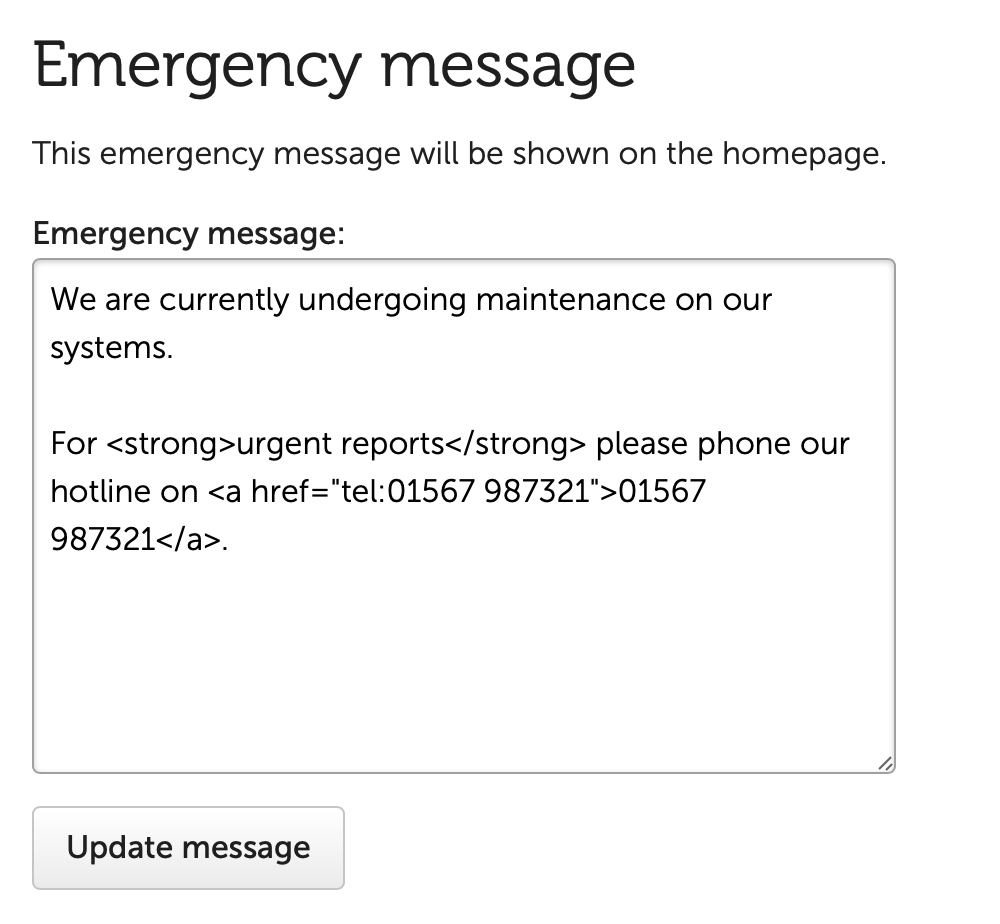

You can set the time periods that will count as out of hours on the same page. For example, if your out of hours were 6pm to 8am Monday to Friday, all day weekends and Bank Holidays, plus Christmas Eve, you would set it up as the following screenshot:
